
A wall panelling in Australia is a solitary layer of material that acts as the uncovered and apparent coating for a wall. It is typically plain and carved into a parametric shape. The warmth and acoustics that wall panels offer, together with the consistency of look, some degree of longevity, and simplicity of replacement, make them practical as well as aesthetic. There really is no fixed dimension for a conductive material that serves these purposes, however to allow for transit, it has been proposed that the largest practicable size for internal walls be between 0.6 and 2.4 m (approximately 1–2 foot).
Interior wall panelling in Australia:
Wall panelling can be installed on a property or home’s inside or facade. Wall panelling was initially employed to improve the cosiness of masonry buildings. The panels are put in place to act as barrier between the chamber and the brick wall. Even now, interior wall panelling has still been employed for this purpose, mostly for aesthetic purposes.
Exterior wall panelling in Australia:
Exterior wall panelling is grown in popularity recently and is frequently used in the development of brand-new, contemporary structures. Wall panels are increasingly popular for a number of reasons. Wall panels can help reduce building expenses since they can be installed “on top” of a building’s structure, eliminating the need for additional work like painting or finishing. An even and constant appearance is the end outcome. In certain cases, wall panelling could even take the place of an entire wall.
Wall panelling in Australia is commonly done to boost the aesthetic of a structure. Wall panelling is becoming more and more fashionable, but there are more alternatives accessible for construction project management. Along with its many utilitarian use, wall panelling also have an aesthetically purpose. Wall panelling in Australia could be utilised to create brand-new, contemporary buildings or to renovate older ones. Wall panelling can improve the structure’s aesthetic impact in both situations. This may be advantageous for borrowing or renting, or it could be done to provide a polished and statesmanlike appearance to prospective customers.
Although certain designs profit from a horizontally special arrangement, wall panels are frequently installed in a vertically triangular prism pattern.
What is weatherboard installation?
Weatherboard installation not only adds visual appeal to your house but also safeguards the outer walls of your building from any harm brought on by precipitation, ice, storm, or lightning. Additionally, it is an excellent insulator, keeping the heat inside and lowering your energy bills.
According on the requirements and the constraints of the sheathing type you’ve selected, weatherboard installation could be installed flat, overlay, diagonally, or crosswise. Although PVCs and fibre cement sheeting have recently gained popularity as newer, more affordable, and higher performing replacements to the historically used hardwood being used in weatherboard installation.
